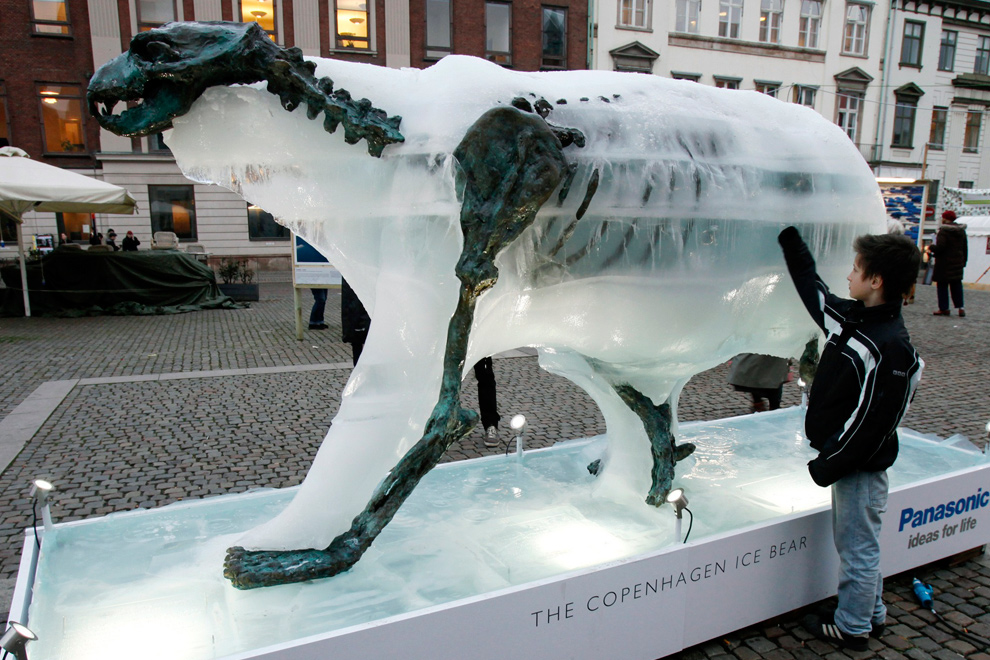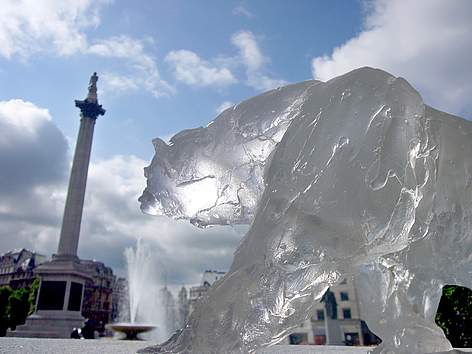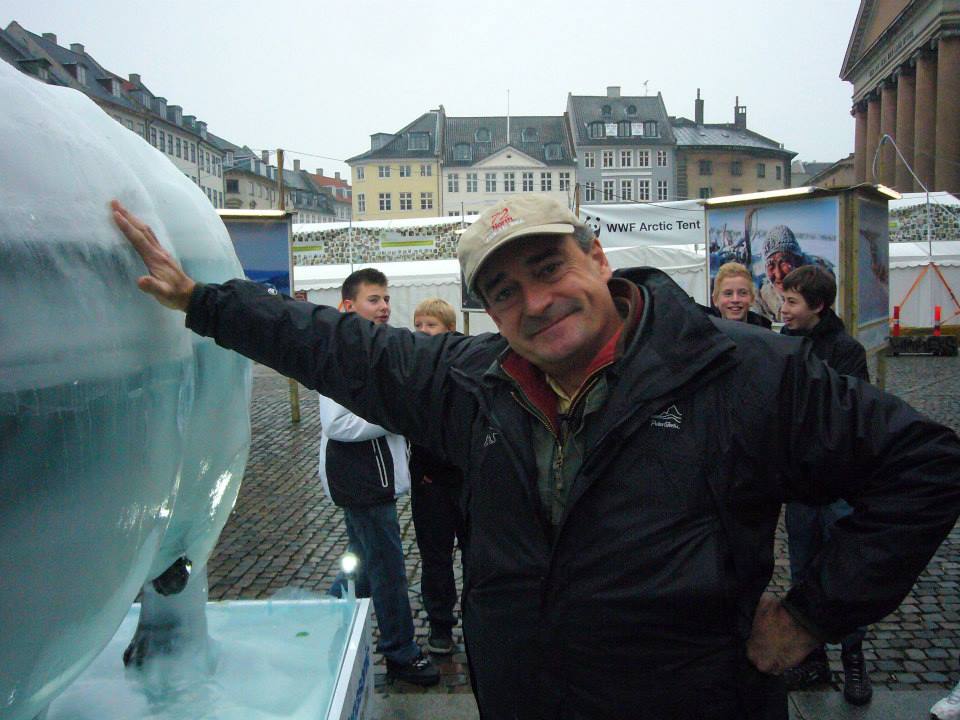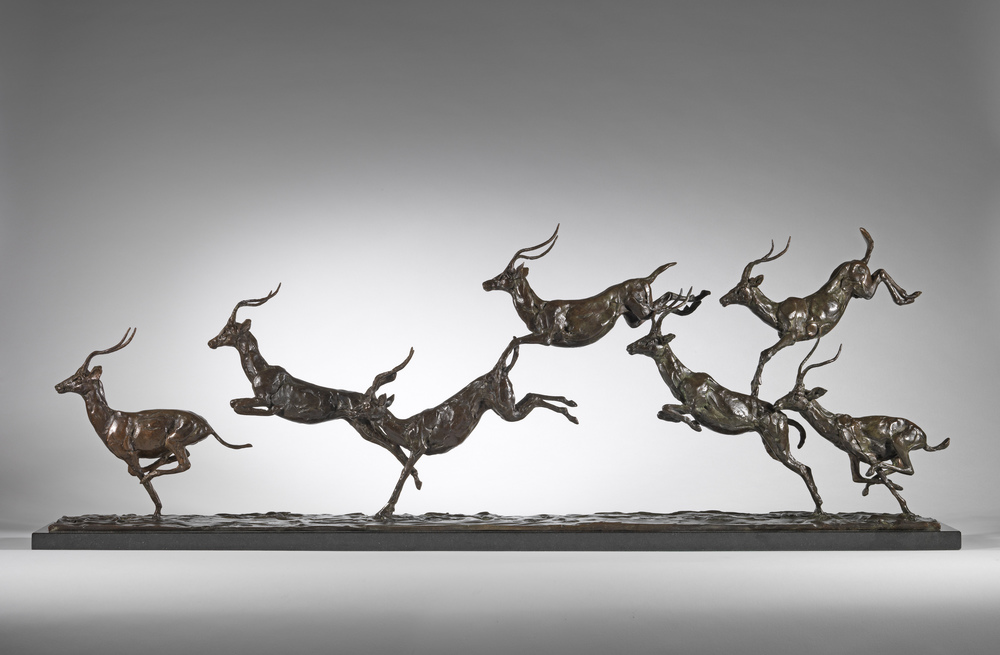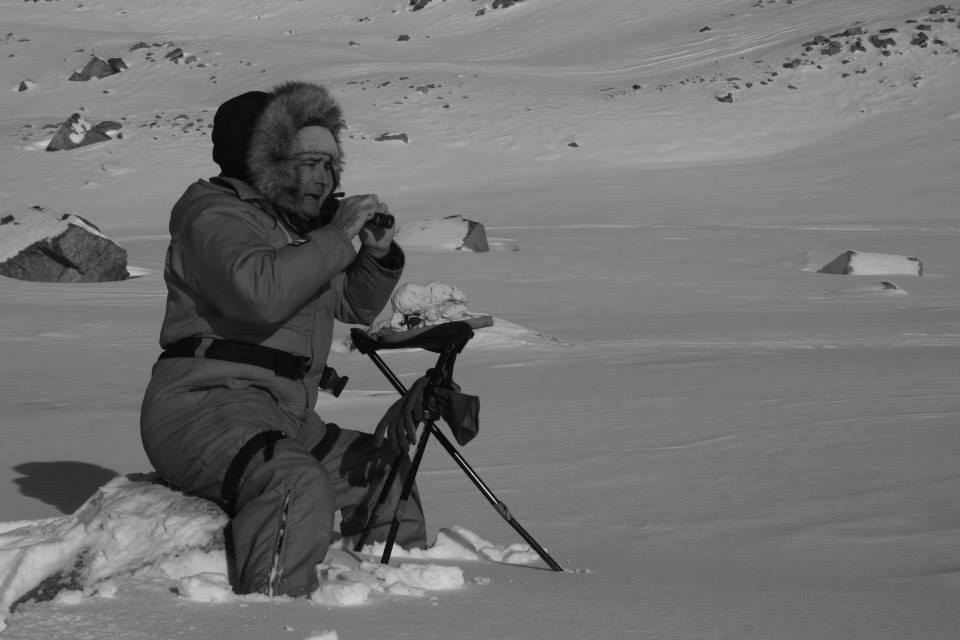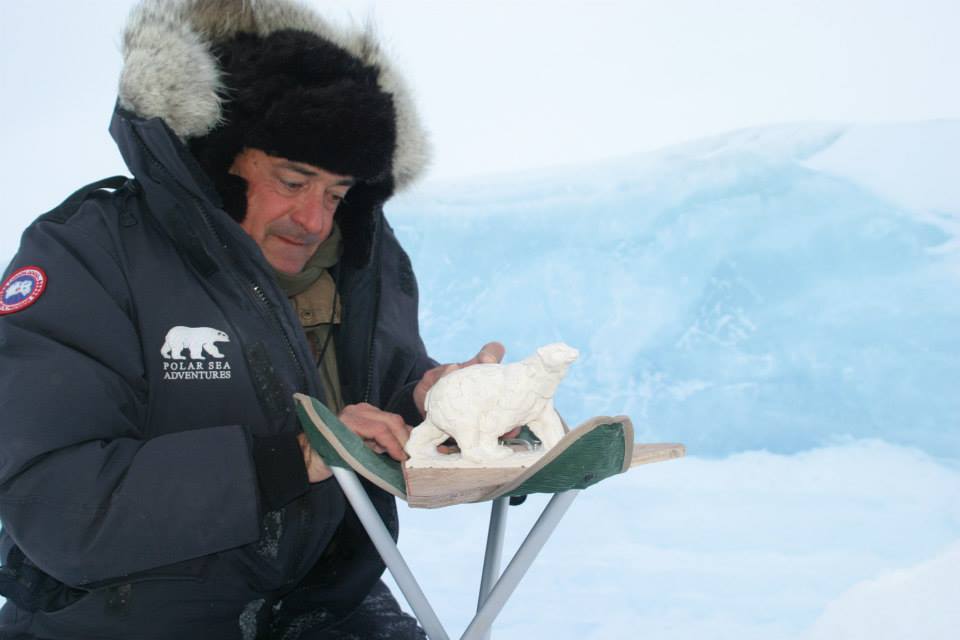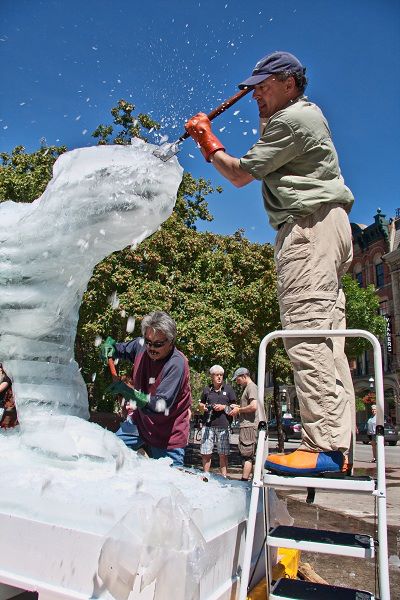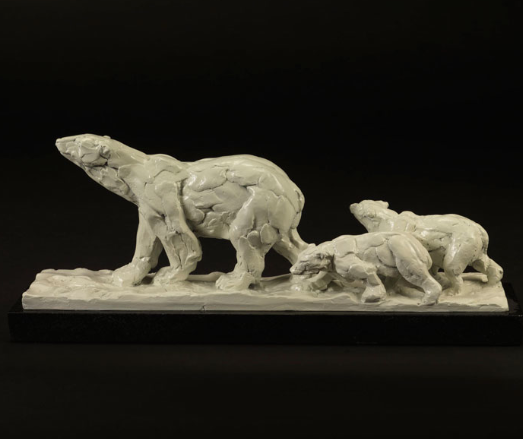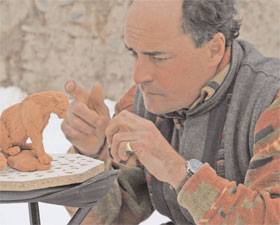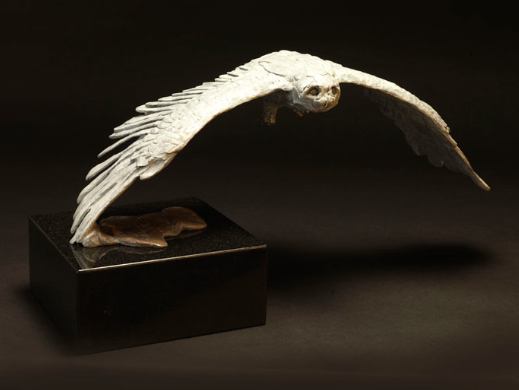“The whole thing is bizarre. But it’s also so emotional, the passion of working with something that is so extremely cold but carved so beautifully. You’re making something that’s not going to last, it’ll melt away and be gone.”
A hulk of ice, carved from an eleven tonne block into a life-size male hunting polar bear. His front legs and haunches are roughly cut. His head is bowed down as if scouring the snowy landscape before him for signs of life. His pristine whiteness is enticing, his body indescribably cold. Anyone is free to touch him. With each human hand, the ice turns to water, eventually leaving behind nothing but a dripping bronze skeleton where the beast used to be.
Conceived by wildlife sculptor Mark Coreth in 2009, the Ice Bear is part of a six-year long project which began during his travels to the Arctic tundras, and ended in his garden in Wiltshire, United Kingdom.“Ultimately we ended up with a skeleton, a pool of water and a powerful message.”
“This idea was sparked by living on the Arctic ice,” explains Coreth. “Carving into the side of icebergs, living with the Inuit guides and watching them hunt. And then trying to sculpt something that would truly tell the story of that part of the world.”
His sculpture, which became part of a collaboration with charity WWF known as The Ice Bear Project, toured cities including London, Sydney and Toronto in order to tell the story of the world’s disappearing icebergs.
“Ultimately we ended up with a skeleton, a pool of water and a powerful message,” he adds.
The message is just as relevant now as it was six years ago. In recent weeks, ice levels in the Arctic reached a record low, raising concerns for already threatened wildlife in the region. On International Polar Bear Day, we look back with Coreth at the incredible story of the Ice Bear Project, his enduring memories of the Arctic and why sculpting wildlife is his lifelong passion.
IPF: Mark, you’re a celebrated wildlife sculptor who has gone from living on a farm in Kenya to creating art for Queen Elizabeth II, The Natural History Museum in London, and putting on shows around the world. What do the animals you sculpt mean to you?
Wildlife is my passion– I was brought up in Kenya amongst all the dynamic wildlife you have there. Movement, life, expanse. You’ve got the cheetah, the impala, the elephant, the lion. I now live and work in the UK, where the world is your oyster. You can sculpt a tiger from the back of an elephant, or go to the Himalayas to sculpt the snow leopard, and by doing this, you get to live and learn the environment of your subject matter.
Speaking of incredible habitats, you visited the Arctic first in 2007 and then again in 2009. What is your most enduring memory of the place?“It doesn’t matter if the sculpture isn’t photographic, but it’s got to have the spirit and the passion.”
The days when you just sit on that ice and see those huge horizons, and everything is stark. You find these extraordinary shapes of icebergs. The shapes of an iceberg are nature sculpting so much better than any human could ever sculpt. Also the ways the Arctic can change, from the harsh blizzards to times of absolute clarity and stillness. It can happen so quickly.
“There’s this feeling of complete privilege sitting on that ice, knowing that you’re seeing something so utterly astonishing.”
And seeing that ice sparked you to create a polar bear sculpture that would carry a message about global warming. You usually work with bronze to make your pieces, so tell us about the moment the idea of working with ice for the first time came to you.
Ice Bear told the story about what I perceived is happening in the Arctic, what I felt the Inuits perceived was happening in the Arctic. I was living on ice, I was carving into icebergs.
Imagine these lovely beautiful bits of natural sculpture, and imagine the icebergs formed from a snowflake that fell way up in Greenland 2,000 years ago. That snowflake fell and was crushed into a glacier, and then borne into the sea, into an iceberg. Then that iceberg was confronted by a sculptor from Tisbury in the UK with a chisel, who starts to carve a polar bear. The whole thing is bizarre. But it’s also so emotional, the passion of working with something that is so extremely cold but carved so beautifully. You’re making something that’s not going to last, it’ll melt away and be gone.
You created a life-size bronze polar bear skeleton using a process called ‘lost wax casting’, which involves making a bronze sculpture from a wax model. How did you then combine ice and bronze to make the polar bear?
I made the skeleton, and then I put it into a box, which was filled up with water and put into an industrial freezer. You pull it out of the freezer and pull the box apart and you’re left with an eleven tonne block of ice. You can’t tell which end is the tail, but in there is the polar bear.
That bear, ultimately I made six times in six different cities. For example, I took the ice to Trafalgar Square, London, and carved it in front of everyone for a bit of theatre. You end up with this ice bear, though you can’t see the skeleton inside because the ice is opaque. If you go and see a life size polar bear, you can’t help but touch it. By touching it, the warmth of your hand melts it, changes it a bit. The magic of this is that you are a sculptor. You are a part of the sculpting team, and that represents human impact on the Arctic.
Imagine the ice beginning to melt down towards the vertebrae on the backbone of the polar bear. That attracts the heat of the day, and it starts to melt it from underneath. That, as far as I was concerned, was so akin to the big black Arctic ocean absorbing the heat of the sun and melting the ice around it.
After the Ice Bear Project was over, what happened to the bronze skeleton?
One dark windy night in 2013, some metal thieves came to my garden and stole it, they ripped it up from a concrete plinth in the ground. It would have been cut up into a thousand pieces and melted down again. My initial reaction was one of complete horror, despair and sadness, but actually when reality came to the fore, I thought, this is really quite a poignant end to the whole story that I was trying to tell. Man had finally completely and utterly destroyed it. The whole story came to an end with the destruction of that skeleton.
“Some metal thieves ripped it up from a concrete plinth in the ground. Man had finally completely and utterly destroyed it.”
Does it make you sad to think that, like the fate of your sculpture, polar bears may not be around for future generations to see?
If we as humans, through carelessness or greed or whatever it may be, have caused the demise of that beast, that saddens me enormously.
Whether you’re looking for snow leopards in the Himalayas or polar bears on the Arctic ice, every sculpture involves going out with local guides and seeing an animal in its natural habitat, however extreme. How do you do it?In my travel backpack, I have a turntable stool, and wire armature. If I’m going to look for snow leopards, I prepare a skeleton in wire about 6 inches long. When I’m up there and I see the movement of the snow leopard, I just bend that wire into the position I’m going to sculpt it, and then mould it with plasticine. It’s really cold, so the sculpture is not brilliant, but what you are producing is made in front of that cat. This to me, is complete magic. You’ve captured the soul of the beast you’re looking at.
To create a polar bear, you’ve got to go and get into the understanding of the bear. The sculpture that you produce back in the studio, is all coming from within. I can close my eyes now and see how that snow leopard is. I can see the tiger from the back of the elephant. It doesn’t matter if the sculpture isn’t photographic, but it’s got to have the spirit and the passion.
Why is it important to keep sculpting in the way you do?
Sculpting what you witness and what you’re finding out there, is hugely important. Give it another 50 years, or 100 years, their environments will have changed. My sculpture of a snow leopard or a polar bear could be an incredibly important moment in time of the extraordinary part of natural history that may be gone in future years. If I can leave a record of the extraordinary world we live in, that would be a legacy I would have been so grateful to have produced.
Finally, do you plan to revive The Ice Bear Project one day, and what else are you planning over the coming months?
I would love to recreate Ice Bear– who knows I might just do so with a bear in a different position or mood!
Wherever you go, the sculpture I make and the exhibitions I put on, are really practices of three-dimensional journalism. You try to tell the story. For example, in April I’m flying out to Romania to investigate European bears. Some of them were captured and looked after appallingly as dancing bears. I’ll be getting a feeling of what their existence is all about. When I come back, I’ll aim to sculpt an exhibition that will really tell the story of the bear. Some may be harsh, some will have rings in their noses or be caged– things you don’t want to see. But it the harsh reality of what’s there. My aim in sculpting is to tell the story, even if it’s a cruel story.To see more of Mark Coreth’s work, visit The Sladmore Contemporary Gallery, which regularly exhibits his latest sculptures.


